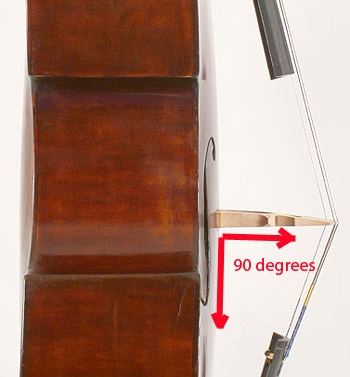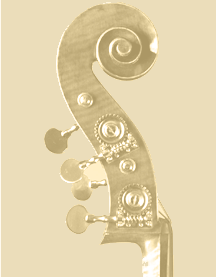Warped Bass Bridge
Just
what causes a bass bridge to warp? There can be a few
different reasons, though even the best, most dense and most
seasoned bridges can warp.
We've noticed over the years that even some of the best known
(better) brand bass makers often will go on the 'cheap' when
it comes to their bridges. Most people (musicians and bass
players alike) will often never think of or consider what kind of
bridge they get or have until way after there are problems.
First, a bridge has to be a well seasoned (dry) wood of maple.
Maple has the proven quality of being one of the most dense woods
and best conductors for sound and vibration. In so many cases,
when we get a new bass in our workshop, we are sometimes shocked by
the lack of quality in some otherwise, expensive basses. The
best bridges are seasoned and stored for years before use. That means that since all of the
excess moisture has naturally evaoporated from the wood, it won't be
subjected to drying type issues: premature shrinkage, warping,
twisting etc... as the wood dries out while on the bass!
On a typical bass bridge with hundreds of pounds of force from
the bass strings, if the wood is not dense and/or strong enough, it
too will eventually warp and often quite quickly.
Even the best French made bridges (like Aubert or Despiau) on the
most expensive basses can warp. This is often not caused by
bad or inferior quality, but the cause in this case is usually when
the bottom flat side of the bridge does not maintain a 90 degree angle
to the top of the bass. (For example, look at the side view of
a bass and examine the angle of the bridge. (Should always
be 90 degrees.) When players buy new strings and they are
changed one at a time, the new strings will quickly stretch, which
requires much tightening. By tightening, you are pulling the
string upwards in the direction of the scroll. This constant
direction eventually pulls the tip of the bridge over to an off
balanced, off centered and puts incredible pressure on the middle of
the bridge, causing it to bend over time.
Sometimes, the seasonal changes will naturally release the
strings in one direction (in the winter) or pull them tighter (in
the summer). Players only need to lay the bass on its side and
examine the angle again to make sure that the bridge remains at 90°.
If the angle seems to lean upwards (towards the fingerboard), or the
other direction, you
only need to carefully pinch or press the tip down (to correct the
angle again).
Somestimes particular brand of strings can easily pull the bridge
over too much, just by using the strings or tuning. The
Innovation strings (slap style) are a loose tension (so not pushing
down too hard on the bridge) therefore make it easier to move and
also because these strings all have round wound wrapping, tend
to hook or grab the bridge tip over very easily.
So there can be several causes for a bridge too warp: Thin,
unseasoned wood, or cheap (light) wood will bend far easier.
Again, even the best bridges will warp if players don't keep an eye
on the angles to make sure that they are still at 90°.
|


